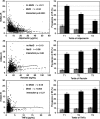Associations of adiponectin, resistin, and tumor necrosis factor-alpha with insulin resistance
- PMID: 18492747
- PMCID: PMC2515087
- DOI: 10.1210/jc.2008-0425
Associations of adiponectin, resistin, and tumor necrosis factor-alpha with insulin resistance
Abstract
Context: Adipose tissue-derived adipokines may contribute to insulin resistance.
Objective: We tested the hypothesis that adipokines are associated with insulin resistance in a community-based cohort and that associations are maintained in people with and without the metabolic syndrome (high vs. low risk of diabetes).
Design, setting, and participants: We studied a cross-sectional sample of 2356 individuals attending the seventh examination (1998-2001) of the Framingham Offspring Study. We measured levels of glucose, insulin, adiponectin, resistin, and TNFalpha in fasting blood samples and defined metabolic syndrome by updated National Cholesterol Education Program criteria. We used ANOVA to test associations of adipokines with insulin resistance and multivariable logistic regression models to assess joint associations of adipokines and metabolic syndrome with insulin resistance.
Main outcome measure: Homeostasis model (HOMA-IR), with insulin resistance defined by HOMA-IR greater than the 75th percentile, was measured.
Results: Age- and sex-adjusted HOMA-IR levels were inversely related to adiponectin (r = -0.40, P < 0.0001) and positively related to resistin (r = 0.13, P < 0.0001) and TNFalpha (r = 0.12, P < 0.0001). The prevalence of insulin resistance increased with decreasing tertiles of adiponectin (from 10.9% in the third to 42.5% in the first tertile; P < 0.0001) and increasing tertiles of resistin (from 19.3 to 30.9%; P < 0.0001) and TNFalpha (from 18.8 to 32.0%; P < 0.0001). Results were similar after adjustment for body mass index. These associations were present in individuals with or without the metabolic syndrome. In multivariable regression models, metabolic syndrome and adipokines individually and jointly were significantly associated with insulin resistance.
Conclusion: Adverse levels of adipokines are associated with insulin resistance in individuals at low or high diabetes risk.
Figures

References
-
- James PT, Leach R, Kalamara E, Shayeghi M 2001 The worldwide obesity epidemic. Obes Res 9:228S–233S - PubMed
-
- Kershaw EE, Flier JS 2004 Adipose tissue as an endocrine organ. J Clin Endocrinol Metab 89:2548–2556 - PubMed
-
- Hanley AJ, Bowden D, Wagenknecht LE, Balasubramanyam A, Langfeld C, Saad MF, Rotter JI, Guo X, Chen YD, Bryer-Ash M, Norris JM, Haffner SM 2007 Associations of adiponectin with body fat distribution and insulin sensitivity in nondiabetic Hispanics and African-Americans. J Clin Endocrinol Metab 92:2665–2671 - PubMed
-
- Tschritter O, Fritsche A, Thamer C, Haap M, Shirkavand F, Rahe S, Staiger H, Maerker E, Haring H, Stumvoll M 2003 Plasma adiponectin concentrations predict insulin sensitivity of both glucose and lipid metabolism. Diabetes 52:239–243 - PubMed
-
- Duncan BB, Schmidt MI, Pankow JS, Bang H, Couper D, Ballantyne CM, Hoogeveen RC, Heiss G 2004 Adiponectin and the development of type 2 diabetes: the atherosclerosis risk in communities study. Diabetes 53:2473–2478 - PubMed
Publication types
MeSH terms
Substances
Grants and funding
LinkOut - more resources
Full Text Sources
Other Literature Sources
Molecular Biology Databases

